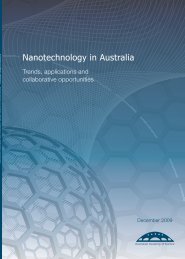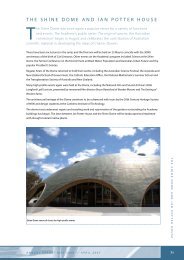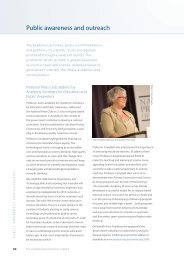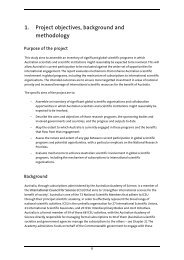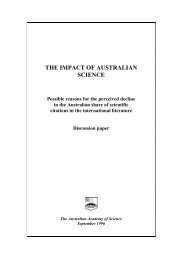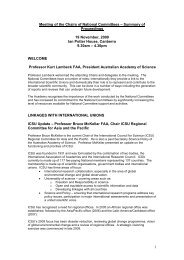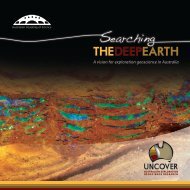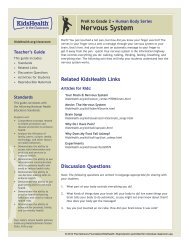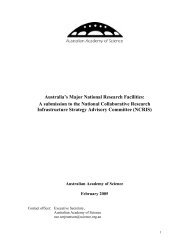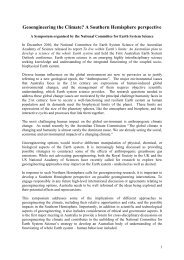ANNUAL REPORT - Australian Academy of Science
ANNUAL REPORT - Australian Academy of Science
ANNUAL REPORT - Australian Academy of Science
Create successful ePaper yourself
Turn your PDF publications into a flip-book with our unique Google optimized e-Paper software.
Ernest Oliver (Ernie) Tuck<br />
Died 11 March 2009, elected to Fellowship 1988<br />
Ernie Tuck was born in Adelaide on 1 June 1939. After the<br />
early death <strong>of</strong> his father in a car accident, he and his younger<br />
brother Bob were raised by their mother. Ernie received his<br />
primary and secondary education at Unley Primary School<br />
and Unley High School, and then went on to study pure<br />
and applied mathematics and physics as an undergraduate<br />
at the University <strong>of</strong> Adelaide, where he graduated with<br />
a BSc in 1959. In 1960, he completed a BSc (Hons) with<br />
first class honours in mathematics. It was here that he first<br />
met Pr<strong>of</strong>essor Ren Potts AO FAA, a connection which would<br />
resume after Ernie returned to the University <strong>of</strong> Adelaide.<br />
Then, having been awarded a John Gellibrand Scholarship,<br />
Ernie moved to the UK to do postgraduate research at<br />
the Department <strong>of</strong> Applied Mathematics and Theoretical Physics at the University <strong>of</strong> Cambridge. Here his<br />
supervisor was Pr<strong>of</strong>essor Fritz Ursell FRS, and Ernie entered the field <strong>of</strong> fluid dynamics with a focus on water<br />
waves, which would remain his lifelong major research interest. Although Pr<strong>of</strong>essor Ursell moved to take up<br />
the Beyer Chair <strong>of</strong> Applied Mathematics at the University <strong>of</strong> Manchester at the end <strong>of</strong> 1961, it was arranged<br />
that Ernie spend his second year at Cambridge and his third year at Manchester. Ernie’s PhD topic was the<br />
application <strong>of</strong> slender-body theory to ship hydrodynamics. This was a completely new field and Ernie’s<br />
approach was revolutionary, based on the method <strong>of</strong> matched asymptotic expansions, which he applied to<br />
the prediction <strong>of</strong> the wave resistance <strong>of</strong> a ship moving in steady motion on the free surface. An indication<br />
<strong>of</strong> the impact <strong>of</strong> this work is that after his second year a small meeting, sponsored by the US Office <strong>of</strong> Naval<br />
Research (ONR), was organised at Wageningen, Netherlands, to discuss his research and the complementary<br />
work <strong>of</strong> Gerrit Vossers on the same topic. That meeting was also attended by Nick Newman and Francis<br />
Ogilvie, another connection which helped to shape Ernie’s career. While at Cambridge, Ernie married Helen<br />
Wood in Trinity College on 21 October 1961. Their son Warren was born in 1965 in Washington DC, and their<br />
second son Ge<strong>of</strong>frey was born in 1969 after they returned to Adelaide.<br />
OBITUARY NOTICES<br />
From 1963–66 Ernie took up a position as a research mathematician at the David Taylor Model Basin, a<br />
research facility <strong>of</strong> the US Navy located just outside Washington DC. Here he linked up again with Nick<br />
Newman and Francis Ogilvie. In 1966–67 Ernie moved to Cal Tech in Pasadena, where he took up a position as<br />
senior research fellow in engineering science, working with Pr<strong>of</strong>essor Ted Wu. In these two periods he worked<br />
on a wide variety <strong>of</strong> research topics in ship hydrodynamics, acoustics, bi<strong>of</strong>luid mechanics and numerical<br />
analysis. His contributions to these fields were based primarily on analytic methods, but it was during this<br />
time that the possibility <strong>of</strong> numerical simulations using high-speed computers emerged. Ernie was quick to<br />
embrace this developing field and combined his theoretical analyses with practical and illustrative results<br />
obtained numerically. Two pieces <strong>of</strong> his research from this period stand out. First, his numerical simulations<br />
<strong>of</strong> nonlinear water waves generated by a submerged two-dimensional dipole in steady motion created great<br />
interest, especially the finding that the streamlines included jets emerging from the free surface. Second, Ernie<br />
addressed the ‘squat’ problem, where ships at high speeds in shallow water can sink vertically. Using slenderbody<br />
theory in the nonlinear shallow water equations, he obtained an elegant and simple theory <strong>of</strong> great<br />
value to ship operators.<br />
In 1968 Ernie returned to the University <strong>of</strong> Adelaide, initially as a reader in applied mathematics, and then in<br />
1974 he was promoted to a personal chair. In 1990, after the retirement <strong>of</strong> Pr<strong>of</strong>essor Ren Potts, he became<br />
the Elder Pr<strong>of</strong>essor <strong>of</strong> Applied Mathematics, named after Sir Thomas Elder, a renowned <strong>Australian</strong> pastoralist,<br />
businessman and benefactor <strong>of</strong> the university. He remained at Adelaide until his retirement in June 2002<br />
when he became an Emeritus Pr<strong>of</strong>essor. During his time at Adelaide Ernie successfully supervised 25 PhD<br />
and four research masters students. He served as head <strong>of</strong> department (1974–75, 1980–81, 1983) and then<br />
112<br />
THE AUSTRALIAN ACADEMY OF SCIENCE



